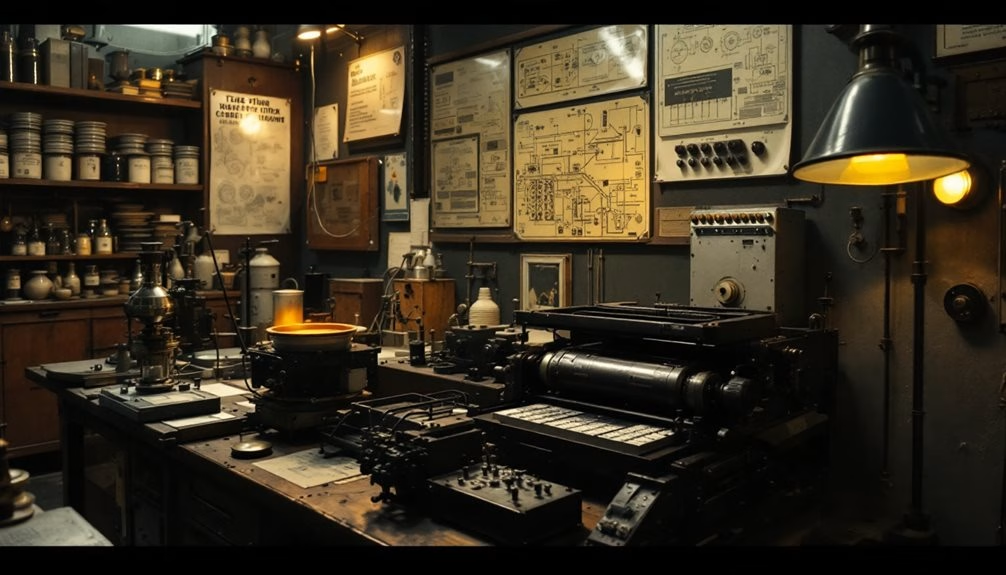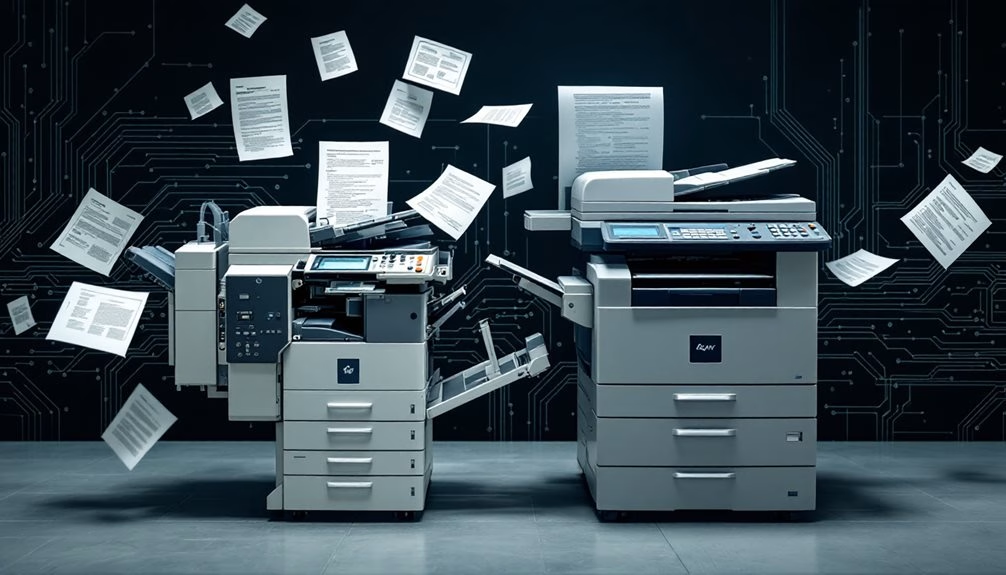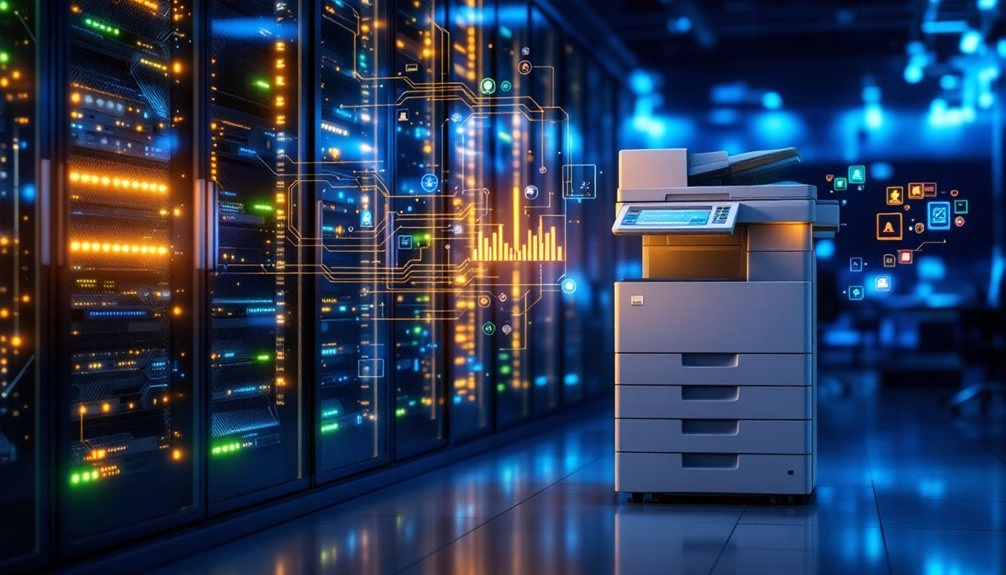We’ve all experienced the evolution of copying technology in our workplaces over the decades. From messy carbon paper to today’s smart multifunction devices, each innovation has transformed how we share and duplicate information. Chester Carlson’s xerography in 1938 sparked a revolution that continues with our modern networked, cloud-connected systems. How did these machines become the intelligent, security-focused workhorses we now take for granted?
Expert Highlights
- Xerography, invented in 1938 by Chester Carlson, revolutionized copying by eliminating chemicals and specialized papers.
- Digital technology in the 1980s enabled multiple copies from single scans and image editing before printing.
- Multifunction devices in the 1990s merged printing, scanning, and faxing capabilities into single space-saving units.
- Networking evolved from local connections to internet and cloud integration, allowing remote printing and wireless document flow.
- Modern copiers incorporate intelligent features like usage pattern analysis, mobile printing, and predictive maintenance.
The Xerography Revolution: Chester Carlson’s Game-Changing Breakthrough

Toiling away in a makeshift lab in 1938, Chester Carlson created the first dry copy on October 22nd—a date that would transform document reproduction forever. His invention, which he called “electrophotography,” would later become known as xerography.
In a humble laboratory, Carlson’s electrophotography breakthrough would revolutionize how humanity duplicates documents.
We’ve come a long way from those humble beginnings. Carlson’s breakthrough eliminated messy chemicals and expensive specialized papers, democratizing document duplication for all of us.
Before his work, we relied on laborious carbon copies or wet processes that were both time-consuming and imprecise.
Xerox Corporation commercialized his technology in the 1950s, bringing push-button copying into our offices and changing how we share information.
Today’s multifunction devices combine Carlson’s legacy with advanced cloud connectivity and security features that transform modern workplace efficiency.
From Analog to Digital: The Transformation of Copy Technology

While Carlson’s xerography revolutionized office productivity with analog copying, the next major leap came in the 1980s when photocopiers began incorporating digital technology.
This shift fundamentally changed how we interact with documents. Instead of using mirrors and lenses to project images directly onto drums, digital systems scan documents into memory first.
We’ve gained remarkable advantages: multiple copies from a single scan, image editing before printing, and network connectivity. Remember when we used to stand beside copiers waiting for each impression?
Now we send jobs remotely and retrieve them later. Digital technology has transformed copiers into multifunctional hubs where our documents enter the information ecosystem.
Modern MFPs continue this evolution with print speeds up to 60 PPM that significantly boost workplace productivity.
The Dawn of Multifunction Devices: Beyond Simple Reproduction

As traditional copiers reached their technological limits in the 1990s, manufacturers began integrating multiple office functions into single devices.
We saw printers, scanners, and fax capabilities merge into what we now call multifunction printers (MFPs).
These all-in-one solutions transformed our workspaces, saving precious square footage while reducing capital expenditure.
We welcomed these innovations as they simplified maintenance and training requirements. Just imagine—one device, one service contract, one interface to learn.
The MFP revolution brought us into a new era where we’re no longer just making copies; we’re managing documents holistically across the digital-physical divide.
Our customers appreciate the factory-trained technicians who maintain these sophisticated multifunction devices to ensure optimal performance and minimize downtime.
Networking and Connectivity: Copiers Enter the Information Age

The integration of office functions marked only the beginning of copier evolution in the digital era.
As networks expanded through offices in the 1990s, our copiers transformed into shared resources that connected us all.
We’ve witnessed remarkable networking innovations that changed everything:
- Local networking (1992-1998) allowed multiple users to share a single device
- Internet connectivity (1999-2005) enabled remote printing and maintenance
- Cloud integration (2006-present) freed us from physical limitations
Today, we’re no longer tied to machines in our hallways.
Our documents flow wirelessly from anywhere, connecting our teams across distances that once seemed unbridgeable.
Modern connectivity facilitates 24/7 monitoring and rapid response to service issues, minimizing downtime for businesses.
Smart Features and Cloud Integration: The Modern Copier Ecosystem

Modern copier technology has evolved far beyond basic reproduction, transforming into intelligent ecosystems that anticipate our needs.
Today’s machines learn our copying patterns and suggest workflows tailored to our team’s habits.
Smart copiers now analyze usage patterns to recommend customized workflows that match your team’s specific needs.
We’ve welcomed cloud integration that lets us scan directly to shared storage platforms, enabling seamless collaboration regardless of physical location.
Mobile printing apps allow us to send documents to office copiers from anywhere, while extensive security features protect our sensitive information.
Many of us appreciate how these smart features reduce wasted time and resources, with predictive maintenance alerting IT before breakdowns occur.
Our copiers have become true workplace partners in our connected world.
From floor-standing models to compact desktop versions, today’s multifunctional devices offer the perfect balance of performance and space efficiency for any business environment.
Frequently Asked Questions
Who Invented the First Handheld Portable Copier?
We don’t have clear records of who invented the first handheld portable copier, though several companies developed early portable scanning devices in the 1990s for our on-the-go copying needs.
How Have Environmental Regulations Changed Copier Design?
We’ve seen environmental regulations transform copiers dramatically. They’ve pushed us toward energy-efficient designs, reduced hazardous materials, and implemented recycling programs for toners and parts in our machines.
What Copier Brands Dominated Different Historical Eras?
We’ve seen Xerox dominate the 1960s-70s, Canon and Ricoh rising in the 1980s-90s, while HP, Konica Minolta, and Sharp have shared market leadership in our digital era.
When Did Color Copying Become Affordable for Small Businesses?
We saw affordable color copying hit small businesses in the mid-1990s when Canon, Xerox, and Sharp introduced machines under $10,000, making vibrant reproductions part of our everyday office life.
How Did Copier Security Features Evolve Over Time?
We’ve seen copier security evolve from basic locks to PINs, user authentication, encryption, and data overwrite features. Now we’re protecting our documents with biometrics and cloud security controls.
Expert Final Thoughts
As we’ve seen, copiers have transformed from simple reproduction machines to sophisticated digital hubs. We’ve witnessed their evolution from Carlson’s basic xerography to today’s cloud-connected smart devices that handle printing, scanning, and document management. They’ve become central to our information ecosystem, and we can expect future innovations to further integrate AI, enhance security, and improve sustainability as our digital workplaces continue to evolve.
About the Expert
Rafael M.
CEO of JR Copier
With over 35 years of hands-on experience in the copier and office printer industry, Rafael brings unparalleled expertise to every client interaction. His journey from service technician to CEO provides him with comprehensive understanding of all aspects of the business.
Areas of Expertise: Copier and printer sales, equipment leasing strategies, maintenance solutions, and managed print services. Rafael's deep industry knowledge ensures clients receive expert guidance, transparent pricing, and exceptional service for all their office equipment needs.
Connect on LinkedIn